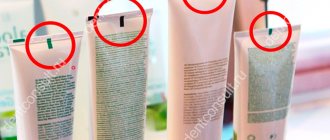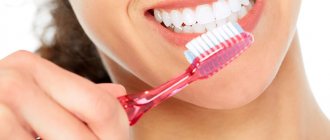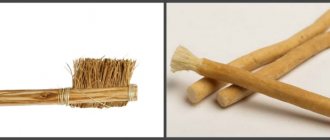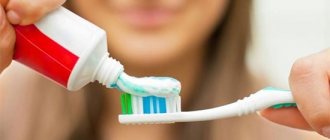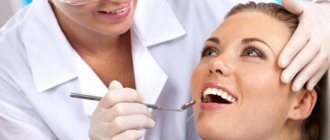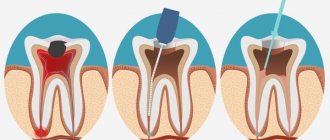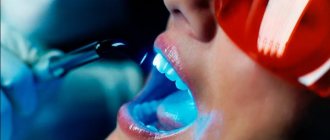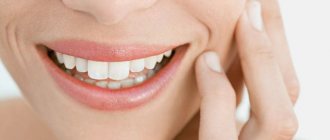230
It is not at all difficult to imagine a person who, in his entire life, has never suffered from, say, heart or kidney disease.
But it is unlikely that there will be an individual who, throughout his entire life, has never experienced problems with his teeth, has not suffered from pain, or has not sought the help of a dentist, surgeon, orthopedist or orthodontist.
Bad teeth are incompatible with a high quality of life. Meanwhile, maintaining their health is not so difficult.
Explanation of the term
The term “intact” (Latin Intactus means “untouched”) is used not only in dentistry, but also in other fields of science and medicine. “Intact organism”, “intact organ”, “intact cell” - all this terminology is quite correct.
As in other cases, the word “intact” in relation to a tooth means undamaged, healthy, normal.
The case where all units in the mouth are intact can be considered ideal. So if your dentist examines your tooth and says that it is intact, this means good news for you. Every person should strive to keep their teeth intact for as long as possible.
Specialists are quite well aware of the mechanism of development of dental diseases, and preventive measures that are highly likely to avoid them. You just need to conscientiously fulfill your responsibilities to your own teeth.
Although there are still situations in which the condition of the oral cavity does not completely depend on the behavior of its owner.
What is an intact tooth?
Many patients, when they hear the term “intact tooth” at a doctor’s appointment, do not understand what we are talking about. Some are nervous, believing that this is a veiled definition of caries or other dental disease. Our article today will clarify this and many other points regarding this topic.
Intact – what is it?
What is an intact tooth in dentistry? Translated from Latin, intactus means “untouched.” Accordingly, an intact one is one that is intact, healthy and not affected by any inflammatory processes or diseases.
Hearing this term in relation to his teeth after a preventive examination, the patient should rejoice.
You can experience twice as many positive emotions if the doctor says that you have an intact dentition, because this means that all the elements in the row are healthy.
Important! The term can be applied not only to the whole tooth, but also to its individual components and structures - enamel, crown, root, periodontal tissue.
The doctor may also use a phrase such as intact surface, but this does not mean at all that the tooth is healthy - it may be affected by caries, pulpitis or periodontitis, but at the same time, areas not affected by infection or destructive processes remain.
Installation of veneers and lumineers
Doctors always resort to preparation of hard tissues before installing prostheses.
Even if you are just going to install veneers or ultraneers to hide the unsatisfactory shade of enamel and diastema, you need to be prepared for grinding.
The frontal surface, even if it is completely intact, will be subjected to minor preparation. How much fabric will need to be sewn? Everything will depend on the thickness of the lining, approximately 0.3–0.8 mm.
On a note! If you decide to improve the aesthetics of the smile area with the help of artistic restorations with a composite, to hide the diastema (interdental gap), for example, then the doctor will also carry out a minor preparation of the frontal surfaces of the anterior units so that the filling materials fit better to them.
You will have to grind the enamel the least if you choose lumineers. However, the doctor will still have to lightly sand it down to a thickness equal to the thickness of the onlay (about 0.3 mm) to ensure high quality fixation and a natural smile.
Prosthetics with bridges
An intact tooth can act as a support tooth for bridge prosthetics. And before installing the structure, it will have to be very thoroughly prepared; trephination (opening) of the crown will be carried out and the pulp will be removed.
Treatment of pulpitis and periodontitis
The physician may touch an intact surface, such as the palatal surface, when treating pulpitis or periodontitis on incisors or canines in order to provide access to the coronal portion of the pulp and root canal orifices. It is not possible to do this from the front side of the cutting edge, since then there is a risk of spoiling the natural shape, aesthetics and functionality.
Bite correction
It is necessary to touch the intact surfaces of some teeth when carrying out a procedure such as separation (grinding). Most often it is used in orthodontics if the bite pathology is minor. The procedure helps to avoid removing some elements of the row. During the process, the doctor grinds off the enamel from the side surfaces and can free up up to 5 mm of space on the jaw.
Reasons for removing intact teeth in adults
We have explained what the term “intact tooth” means. But sometimes an unpleasant surprise for patients in dental clinics is the need to remove such units. Let us list the reasons why an extraction procedure may be required.
Orthodontic bite correction
There are often clinical cases in which, before treating malocclusions with braces or aligners, some teeth must first be removed. This is done to free up free space on the jaw. In this case, the intact tooth itself may have a normal location, but it has to be sacrificed. Often the third molars are removed, less often the second and first ones.
On a note! The definition of intact is a tooth that is not affected by dental diseases such as caries, pulpitis or periodontitis. However, it may be curved, occupy an incorrect position in the row, be supernumerary, or have signs of macrodentia (crowns that are too large in size) or microdentia (small crowns).
If the unit is intact or has an oversized crown, it will most likely have to be removed before braces can be placed.
Treatment of adjacent teeth
The need for this arises when treating periodontitis or removing an overgrown tumor (cyst, abscess, granuloma).
To ensure good access to the problem area, a specialist has to carry out large-scale work. Sometimes this leads to damage to perfectly healthy teeth, and their roots are exposed. Of course, such cases mostly indicate the unprofessionalism of the dentist, and to avoid them, you need to contact only experienced doctors.
Preparation for prosthetics or implantation against the background of multiple edentia
It also happens that a patient has several intact teeth in his mouth, but all the rest are missing. Of course, a partial removable structure can be supported on them, if the clinical situation and their location allow, but in some cases it is more advisable to completely remove them and replace them with a complete removable denture, or with a fixed prosthesis supported by implants.
Why remove intact milk units?
This must be done in cases where the time frame for changing milk units to permanent ones is delayed. At the age of 7–8 years, permanent teeth begin to erupt, but temporary teeth should begin to fall out, but not all children have this process smoothly.
It also happens that the dairy ones, due to excessive mineralization or due to the individual characteristics of the body, do not even wobble, although the rudiments of permanent ones are already resting on their roots.
If such elements are not removed in a timely manner, the permanent ones may make their way into the second row. This can cause crowding and malocclusion in adulthood.
Rules for maintaining oral health
The main preventive measures against the development of dental diseases are proper oral hygiene and regular visits to the dentist.
Teeth do not become sick instantly. It takes a certain amount of time for an intact unit to become carious or pulpitic.
Regular visits to the dentist once every 3-6 months allow you to promptly notice signs of trouble and take preventive measures to stop the development of the disease.
Demineralization of enamel, the presence of soft and hard plaque, increased tooth abrasion, malocclusion creating periodontal overload - all these signs will be detected by the doctor during examination, and treatment or preventive measures will be prescribed. As a result, the development of an unfavorable situation will be stopped, and the unit will remain intact.
Good oral hygiene is considered the main condition for keeping teeth healthy. Over the past centuries of development of scientific dentistry, the causes and mechanisms of dental diseases have been studied in sufficient detail. It has been established that in most cases, poor oral hygiene is the main cause of dental disease.
Food debris that is not removed from the oral cavity becomes a breeding ground for cariogenic bacteria. Acids produced by microorganisms corrode the enamel, forming a carious cavity, which, spreading deeper and wider, destroys the tooth crown, reaches the pulp chamber and inflames the pulp, leading to the need for depulpation.
The fight against caries and tooth decay should begin with mastering proper oral care. The main goal of hygiene is to prevent the formation of plaque (plaque), which involves regular brushing of teeth with a brush and toothpaste.
Indications for removal in adults
An intact tooth is good news for any patient. However, it does not mean that such a unit should be retained in any case. It must be understood that the term “intactness” affects only the condition of the enamel and dentin, but not the position or condition of the periodontium.
That is, a tooth with healthy hard tissues not affected by destruction may be incorrectly positioned (dystopic), erupt with a delay (be impacted), stagger due to periodontal destruction, and interfere with the treatment of other units. In this case, you may need to remove it.
Clinical situations when a healthy tooth needs to be removed:
- Its presence interferes with proper orthodontic or orthopedic treatment. In the first case, the indication for removal may be the crowded position of the teeth and lack of space for them.
To free up additional space, the first premolars or canines are usually removed, often on both sides. The tooth may interfere with the installation of the prosthesis. In this case, it is also removed. - Supernumerary of intact units.
- Impacted intact teeth , which for one reason or another are impossible or impractical to “pull out”.
- Dystopic or tilted intact units, if their correction is considered undesirable.
- Tumors or cysts in the area of healthy teeth.
The intact units removed may be the third molars.
Most often, healthy teeth are removed during orthodontic treatment. But, in any case, before deleting them, all possible options are analyzed and the most appropriate decision is made.
Characteristics of compomer materials and their purpose.
Come here if you are interested in how to remove plaque.
At this address https://www.vash-dentist.ru/lechenie/zubyi/ispolzovanie-prokladok.html we’ll talk about medicinal dental dams.
Intact tooth: description, feature, preparation for prosthetics, advice from dentists
What is an intact tooth? What features does it have? You will find answers to these and other questions in the article. The process of chewing food has depended on intact teeth since ancient times. Keeping them intact and healthy with the current variety of food and drinks containing chemical substances is the most important task for any person. Let's find out what intact teeth are.
Description
There is no need to worry if the doctor said that you have intact teeth. Moreover, you should be happy about it. The fact is that this term refers to healthy, normal teeth.
The word “intact” comes from the Latin intactus, which means undamaged, untouched, not involved in any process. This means that such teeth are not affected by periodontal disease, caries, pulpitis and other ailments that affect the oral cavity.
Needless to say, an individual who has a whole row of intact teeth is simply lucky. It's not all about luck though.
Dental health
Everyone knows from childhood that there is nothing more important than your health. This is one of those things that money cannot buy. After all, they can only help a little to correct the undermined state of health. But many people take their health for granted until it is too late. This also applies to dental health.
Everyone knows that for preventive care you need to visit the dentist at least once every six months, but only a few do this. As a rule, a person does not have the desire or time for such seemingly useless trips.
What stops people from going to the doctor is usually a groundless fear of dentists. This fear is unfounded, since even the most insignificant operations are performed under anesthesia, which completely numbs the pain, even a couple of hours after the medical procedure.
Most often, a patient consults a doctor when the gums and cheeks become swollen, and the toothache becomes unbearable. And that is why many with such a negligent attitude towards their health do not know basic medical terms.
Preventive measures
Many people ask: “Intact tooth - what does it mean?” If a person has such a tooth, that’s great. And you need to understand that being strong and healthy is not a luxury at all. Many people have absolutely healthy and straight teeth since childhood. All that is required of a person is to maintain impeccable oral health for as long as possible.
In theory, an individual's own teeth can last a lifetime, of course, if they are properly cared for. Dentistry is a medical field in which many ailments can be prevented thanks to simple preventive measures. This kind of fencing does not require you to spend much in terms of finances or time, or require significant effort.
Each child is explained that the basic preventative measure for dental ailments is oral hygiene. This complex means the elimination of various harmful deposits and food debris from the surface of the gums, cheeks and teeth.
An excellent assistant in this are the well-known dental floss, toothpaste and brush. It is impossible to clean your mouth of all deposits with one brush.
If you want to protect your oral cavity 100%, visit the dentist's office occasionally for a complete preventative cleaning.
Do not overuse too cold or hot, sweet or sour foods and drinks. This can negatively affect the integrity of the enamel. Also, you should not expose your jaw to very strong mechanical influences. And don’t forget about consuming calcium and vitamins.
Reasons for deletion
But not everyone is lucky with healthy teeth. Sometimes they grow crooked, uneven, and sometimes you can lose a tooth due to some kind of accident. To prevent various inconveniences associated with eating, as well as restore an outwardly attractive appearance, the dentist may decide to remove and replace the tooth.
It is known that prosthetics is a very complex and delicate operation, therefore, neighboring, intact (healthy) teeth can be used to effectively secure the denture. Most often they are cut, then ground and covered with crowns. Sometimes they have to be removed completely if, for example, their roots were greatly exposed during the operation.
When getting prosthetics, you must be prepared to make significant sacrifices, especially if you need to install a prosthesis on the entire dentition. Here, unfortunately, it may be necessary to remove several healthy teeth at once.
So, if there are only one or two intact teeth left on one jaw, the doctor can remove them and then install a complete denture covering the entire dentition. There is no need to be alarmed here, since current dentures are identical to your natural teeth and you will not feel any difference. It should be noted that the placement of teeth along the intact dentition plays an important role during such an operation.
Removal of healthy teeth in children
Almost all babies have intact milk teeth. In childhood, healthy and cured incisors are removed to shape the bite and regulate the growth of the jaw system. The fact is that the size and number of teeth, their pattern of change, and the relationship with the type of face affect the harmony of appearance. Intact primary canines and incisors are removed by the time of their natural replacement.
The timing changes taking into account the personal characteristics of the body, so the indication for the removal of a healthy tooth becomes its stability later than the physiological average period or mobility before the replacement date.
To find out why a healthy tooth has become mobile, the doctor takes an x-ray. An intact incisor may be pulled out due to tightness in the row to prevent malocclusion. The orthodontist determines the presence of indications for the removal of healthy baby teeth based on the results of testing.
As a rule, teeth are removed symmetrically so that the bite is formed correctly and the pressure is distributed evenly. With permanent and mixed dentition, the doctor can pull out intact permanent teeth if they grow out of line. To make room for a misplaced tooth, a decayed or less valuable tooth may be removed.
Preventing bite problems
An effective way to correct the growth of the jaw bones and form the correct bite is to remove a permanent tooth. This leads to the fact that nearby rudiments move and will immediately erupt correctly.
This procedure prevents the worsening of bite problems and speeds up orthodontic treatment. Usually, symmetrical elimination of the rudiments of third molars, premolars on one or both jaws is prescribed.
Trephination of the tooth cavity
Let's touch on the topic of trephination techniques for intact teeth. Opening a tooth cavity - creating a point connection between a carious cavity and a tooth cavity or forming access to the tooth sinus at one point. Dental cavity opening - removal of the arch of the tooth to create access to the root canals.
In this case, the dental cavity cannot be deformed or expanded, but its bottom and walls must be visible. The opening and opening of the dental cavity of each group has its own characteristic features. Most often, these actions are performed through a carious cavity.
But sometimes the doctor needs to perform trepanation of the crowns of intact teeth. In this case, he prepares the carious cavity according to all requirements. The dental cavity is opened with a thin tip of a probe or a spherical bur No. 1. Trephination of the tooth crown is carried out with a turbine drill with a carbide or diamond bur.
Trepanation, for example, of the crowns of intact incisors of the lateral upper jaw is performed from the palatal surface in the area of the blind fossa. To avoid such a procedure, take care of your health from childhood and use high-quality hygiene products.
Source: https://FB.ru/article/422910/intaktnyiy-zub-opisanie-osobennost-podgotovka-k-protezirovaniyu-sovetyi-stomatologov
Problems in children
In children, there is sometimes a need to remove intact milk jugs. Most often this happens with anomalies in shape and position (narrowed jaw, for example), when a healthy element prevents correction. Dystopic “milk jugs” must be removed.
Removal of intact units may require their instability before the biological change of occlusion. The most favorable time for this is the eruption of the first permanent molar.
As in adults, indications for extirpation are cysts and tumors in the alveolar region.
Violation of facial proportions and the need for their correction may also require removal of an unaffected unit.
Important. Removal of a healthy milk jug should have strong indications based on diagnostic results, including radiographic ones.
The absence of a milkman may have an adverse effect on the primordia and growth of permanent units.
Prevention measures
All various preventive measures that help keep teeth healthy can be divided into 4 groups:
- Regular visits to the doctor.
- Proper oral hygiene.
- Power control. Providing the body with nutritional components that ensure the proper development of the dentofacial apparatus. Acceptance or, on the contrary, exclusion of those products that, by their physical form, are beneficial or harmful to the condition of enamel and dentin.
- Improved overall health.
Visiting a doctor for preventive purposes
As already noted, you need to visit the dentist at least 2 times a year. The optimal frequency is considered to be once every 3 months. During a preventive examination, the doctor will definitely notice the onset of the disease and take the necessary measures.
Reasons for performing dental trepanation and the specialist’s course of action.
In this publication we will discuss the importance of photodynamic therapy in dentistry.
Here https://www.vash-dentist.ru/lechenie/zubyi/lidoksor-partner-stomatologa.html all the most important things about the drug Lidoxor.
Oral care
You need to brush your teeth at least 2 times a day: the first time in the morning after meals (you can rinse your mouth before breakfast), the second, mandatory time, in the evening after dinner. Pre-night cleaning is more important than the first, because if it is not done, food debris will remain in the oral cavity for a long time.
To clean the proximal space, you need to use brushes and floss.
You should begin and end brushing by rinsing your mouth with mouthwash or clean water.
The brush is changed once every 2-5 months , the paste - every 1.5-2 months. The bristles should not be very hard, suitable for enamel and gums, the brush head should not be traumatic. It is advisable to periodically use specialized pastes with fluoride, calcium, triclosan, whitening, and medicinal herbs.
To clean MVPs and orthodontic appliances, it is recommended to use superflosses - thinner threads of a special structure.
You also need to clean your tongue with a special scraper.
Do not use foreign objects, such as needles, for cleaning. Even toothpicks should be used carefully, without excessive zeal, so as not to damage the enamel or injure the gums.
Nutrition
Food must contain all the components necessary for the body. Too sweet and sour foods are considered harmful to enamel and dentin; it is advisable to reduce their intake.
The menu should contain not only soft, but also fairly hard foods that partially cleanse the teeth of soft plaque and create a healthy load for them. At the same time, too hard (nuts, crackers) and viscous (toffee) foods should be excluded from the diet.
General health
It has been established that there are cause-and-effect relationships between caries and certain diseases and conditions. Susceptibility to caries increases with Kashin-Beck disease, hypothyroidism, rheumatism, and changes in hormonal status.
Pregnancy is a predisposing factor to caries. Radiation therapy used in the treatment of tumors of the head and neck is very dangerous for the condition of enamel and dentin.
Heredity also influences a person's susceptibility to caries.
The exact mechanism by which general health affects dental health is not fully understood. However, it is assumed that the connection between them is determined by the pulp, which contains blood vessels that feed dentin and enamel, the composition of the oral fluid and the condition of the periodontium.
For all of the above cases, special preventive measures have been developed that reduce the risk and severity of mediated dental diseases. They should be used on the recommendation of a doctor.
Learn how to keep your teeth healthy from the video.
Intact teeth - What does this mean, what to do with them?
Navigation:
- How to Maintain Oral Health
- Reasons for deletion
A healthy body is the main wealth of a person that needs to be protected. In addition to a healthy lifestyle, you should regularly visit doctors for preventive purposes, without waiting for dental diseases.
Many people who regularly visit the dentist are familiar with the expression intact teeth. Some have never heard of him at all. Should you worry when a doctor uses this term in relation to your chewing organs? No, you shouldn't worry, you should be happy! After all, an intact tooth is a completely intact organ. He is normal, untouched by disease.
There is no need to involve him in any therapeutic process.
Remember! To keep the incisors, fangs, and molars completely healthy, you need to work on this every day, take care of your oral cavity, and visit the dentist. This is the only way to prevent caries, fillings, periodontal disease, stomatitis, pulpitis, gingivitis and other diseases.
Fluoridation of enamel may be required to maintain health. If your dentist recommends such a procedure, you should not refuse it. Its peculiarity is that it saturates the enamel layer with useful elements.
Various preparations containing fluoride are used. They strengthen the hard layers of the crown, make them resistant to acids, and slow down metabolic processes in pathogenic bacteria.
All this contributes to the strength of the enamel, eliminating the sensitivity of units, and extending the service life of the chewing organs.
With simple fluoridation, mouth guards filled with a special gel or varnish are used, which is applied with a brush. This creates a protective film on the surface of the enamel. Sessions are held every six months. Deep fluoridation is a more complex procedure.
Its efficiency is higher, since special enamel is used, as well as sealing mixtures containing copper, fluorine, magnesium, and calcium hydroxide.
During the interaction, the drugs form compact crystals that penetrate the pores and seal them, protecting the units from negative factors.
How to Maintain Oral Health
Intact teeth are not only good genetics, but also the result of careful care. It is important not to waste time, regularly treat the oral cavity, protect it from harmful bacteria. Basic rules for maintaining the health of the chewing organs:
- Proper balanced nutrition.
- Careful and systematic home hygiene.
- Regular dental examinations for preventive purposes.
You should take care of your oral cavity at home every day by choosing the right brush, paste, floss, and brush. As a result of this procedure, most pathogenic accumulations are removed from the surface of the crowns and gums.
True, you won’t be able to get rid of all the dirty deposits on your own. To solve this problem, it is necessary to remove plaque in a dental office.
The hygienist will be able to carry out complete prevention of oral diseases.
Dentists advise to beware of food that is too cold or hot, or too sour or sweet. Do not load the chewing organs with strong mechanical actions. You should always remember the benefits of vitamins and calcium for hard tissues and mucous membranes.
From an early age, children need to be explained that the main preventive measure for oral diseases is careful hygiene, removing food particles and harmful plaque from the gums, cheeks, tongue, and crown surfaces.
It is best to use a brush that has:
- Artificial pile with rounded edges;
- A head that does not cause injury to soft tissues;
- A handle that is comfortable to hold;
- Villus hardness suitable for enamel and gums;
It is useful to disinfect the brush using a special solution. The accessory needs to be changed at least once every three to four months. Dentists warn against picking your teeth with sharp steel objects.
They scratch the enamel layer. Through these holes, pathogenic bacteria penetrate into the unit. After eating, you can use a wooden toothpick and rinse your mouth.
Just use toothpicks carefully so as not to injure your gums.
Reasons for removing intact teeth
Not everyone can boast of healthy chewing organs. If the oral cavity is neglected, as well as for preventive purposes, dentists prescribe ultrasonic teeth cleaning.
The procedure consists of cleaning the crowns itself and further polishing with special pastes.
The advantages of this measure include high efficiency in the removal of soft plaque and stone, as well as excellent prevention of diseases of periodontal and gingival tissues.
The chewing organs may be uneven, crowded, or protruding from the row. Sometimes they lose units in an accident, as a result of an unsuccessful fall or a strong blow.
In such cases, in order to eliminate inconveniences, difficulties when eating, and restore an attractive appearance, the dentist may decide to extract and subsequently prosthetize the units.
Successful implantation and successful installation of the prosthesis may require the participation of neighboring healthy organs. They are most often ground down to install an artificial crown.
Sometimes it is necessary to remove intact units when their roots are very exposed. Installation of a full-row prosthetic structure may require the extraction of several normal masticatory organs. Whole baby teeth are sometimes removed in children due to improper development of the jaw system, as well as the formation of an unhealthy bite. Besides:
- An excessive number of them leads to the removal of units.
- Extraction is performed if the dimensions of the units cause discomfort.
- The dentist makes a decision on the operation if there is no combination of units with the type of face.
- Removal may be required if the pattern of change in the masticatory organs is incorrect.
Almost everyone at birth receives a whole set of healthy incisors, canines, and molars. the challenge is to keep them healthy for as long as possible. To do this, you should take diligent care of your oral cavity and regularly visit the dentist.
Source: https://ArteStom.ru/blog/intaktnye-zuby/
